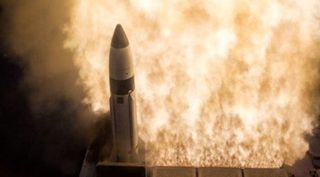SM-3 Interceptor Misses Mark in Complex Test

WASHINGTON — A Raytheon-built Standard Missile 3 Block 1B interceptor failed to hit a medium-range ballistic missile Oct. 31 in a complex U.S. Missile Defense Agency test involving multiple targets.
The test, announced by the agency after the fact Nov. 1, called for the Aegis Ballistic Missile Defense and Terminal High Altitude Area Defense (THAAD) systems to take on two ballistic missile targets while the former simultaneously conducted an "anti-air warfare operation." The Aegis system uses the SM-3 as its ballistic missile interceptor.
It was the first test failure involving an SM-3 variant since October 2012, breaking a string of six straight successes. The SM-3 Block 1B, an upgraded version of the Block 1A, was declared operational last year. [The Most Dangerous Space Weapons Concepts Ever]
In its press release, the MDA said the Oct. 31 events were part of a "complex" demonstration of a "layered defense architecture."
At about 11:05 p.m. local time, a U.S. Air Force C-17 aircraft near Wake Island in the western Pacific Ocean launched a short-range missile target. The target was detected by a AN/TPY-2 radar in terminal mode and a THAAD interceptor launched and successfully intercepted the target.
At the same time, a second C-17 launched a medium-range ballistic missile. This target was detected and tracked by an AN/TPY-2 radar in forward-based mode and by a AN/SPY-1 radar aboard the USS John Paul Jones, which is equipped with the Aegis Ballistic Missile Defense system.
Almost immediately after that launch, a BQM-74E air-breathing target launched from a test support plane.
Get the Space.com Newsletter
Breaking space news, the latest updates on rocket launches, skywatching events and more!
Both the Aegis and THAAD systems launched interceptors at the medium-range missile. The SM-3 Block 1B, launched from the John Paul Jones, was the first to engage the missile but missed its mark due to what the MDA characterized as an anomaly with the interceptor.
The THAAD interceptor subsequently hit the target.
Meanwhile, a Standard Missile-2 Block 3A guided missile from the Aegis system successfully approached the air-breathing target and would have destroyed it had it been carrying its explosive warhead, the MDA said. As planned, the interceptor was not carrying the warhead, meaning the target can be used again, the agency said.
The MDA's experimental Space Tracking and Surveillance System satellites observed the launches and gathered data for future analysis, the release said.
The MDA has begun an investigation into the failed SM-3 intercept. Amanda Schildt, a spokeswoman for SM-3 prime contractor Raytheon Missile Systems of Tucson, Arizona, referred questions about the test to the MDA.
This story was provided by SpaceNews, dedicated to covering all aspects of the space industry.
Join our Space Forums to keep talking space on the latest missions, night sky and more! And if you have a news tip, correction or comment, let us know at: community@space.com.
Mike Gruss is a veteran defense reporter and Editor-in-Chief of Sightline Media Group, which includes Army Times, Air Force Times, Dense News, Military Times and Navy Times. From 2013 to 2016, Mike served as a Senior Staff Writer for SpaceNews covering national security space programs and military space policy in the U.S. Congress. Mike earned a bachelor's degree in English and American Studies from Miami University and has previously wrote for the Journal Gazette in Fort Wayne, Indiana and the Virginian-Pilot in Virginia before joining SpaceNews. Prior to joining Sightline in 2017, he was a senior editor of FedTech magazine covering technology in federal government. You can see Mike's latest project on Twitter.

